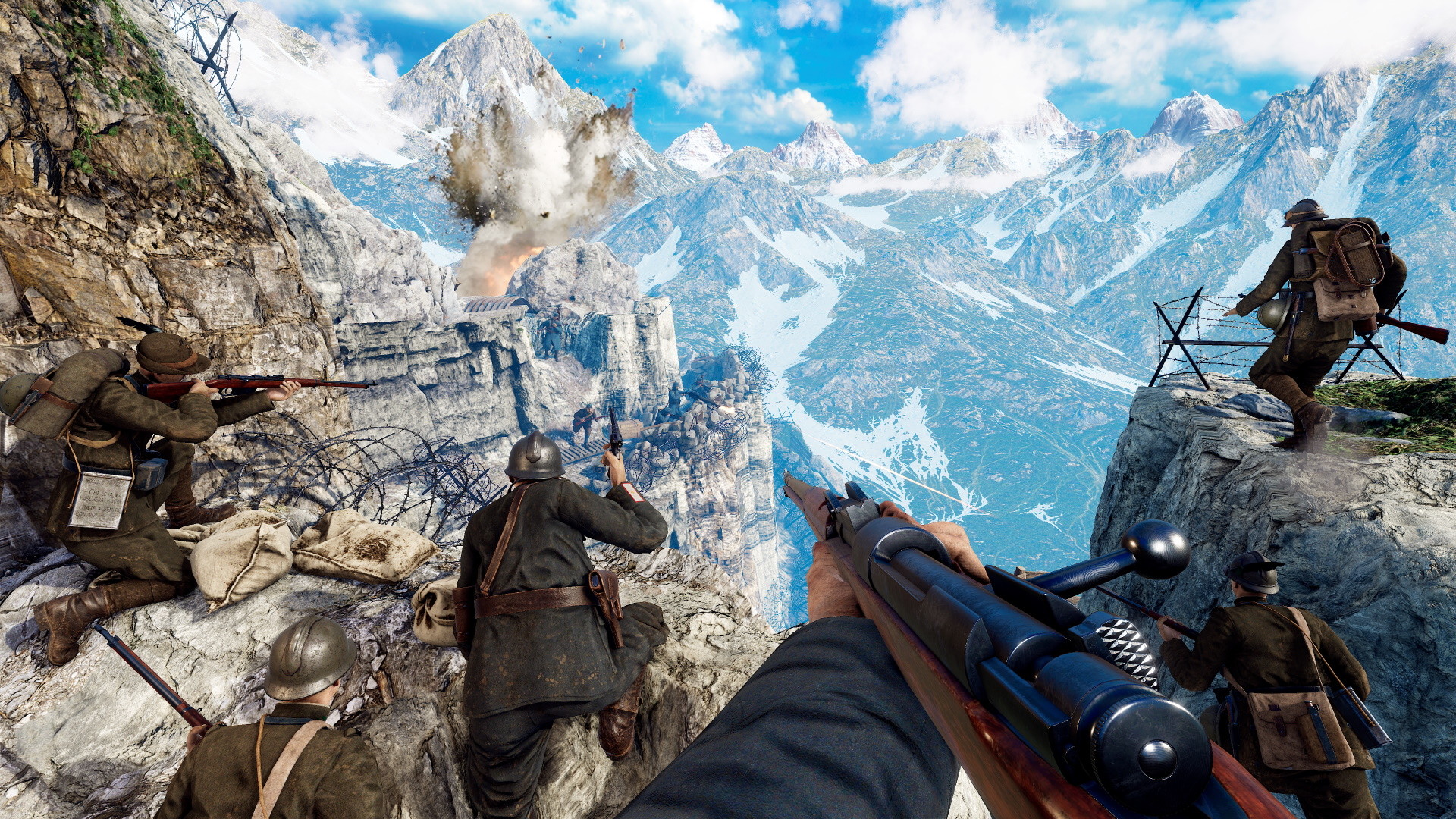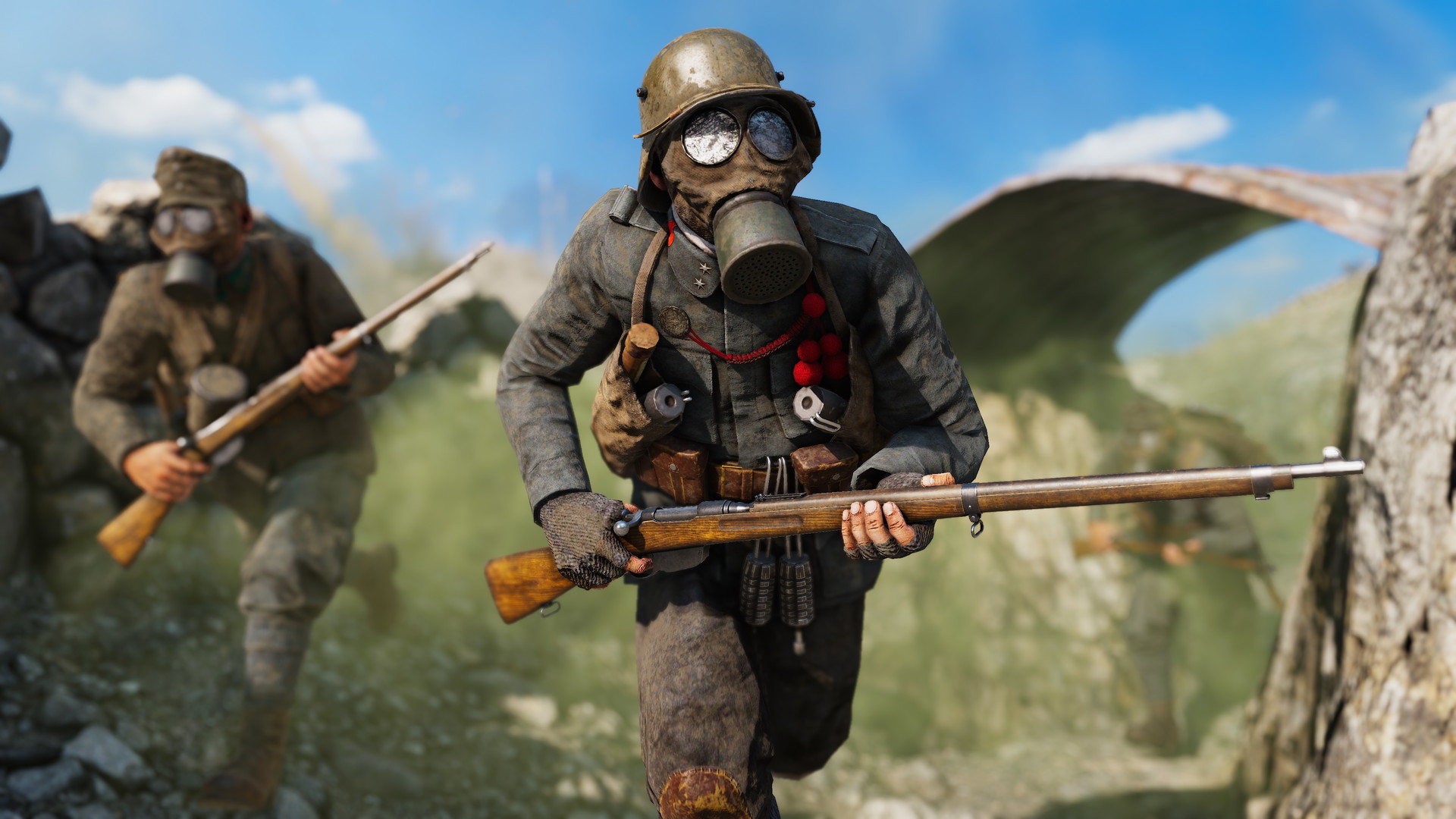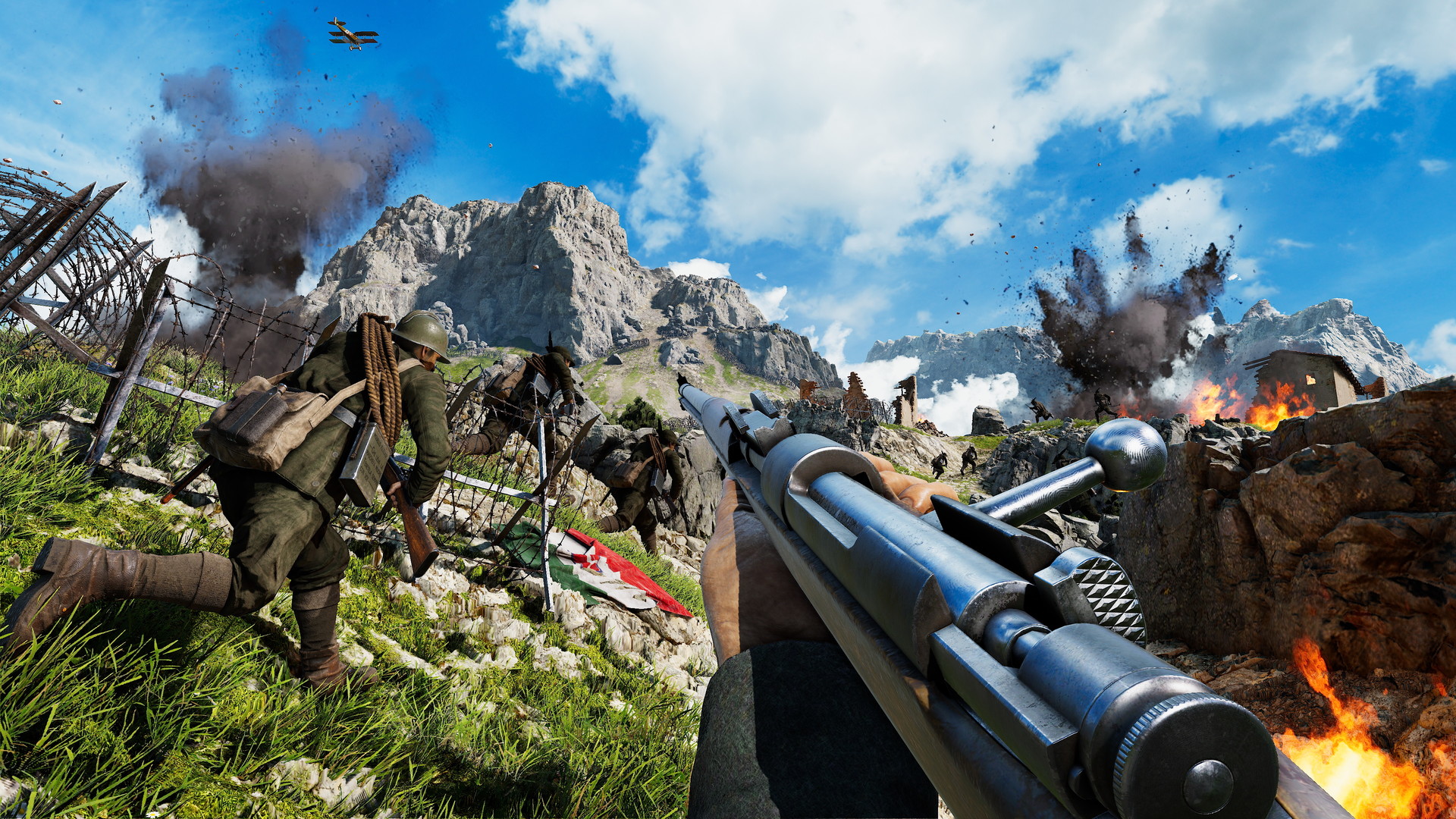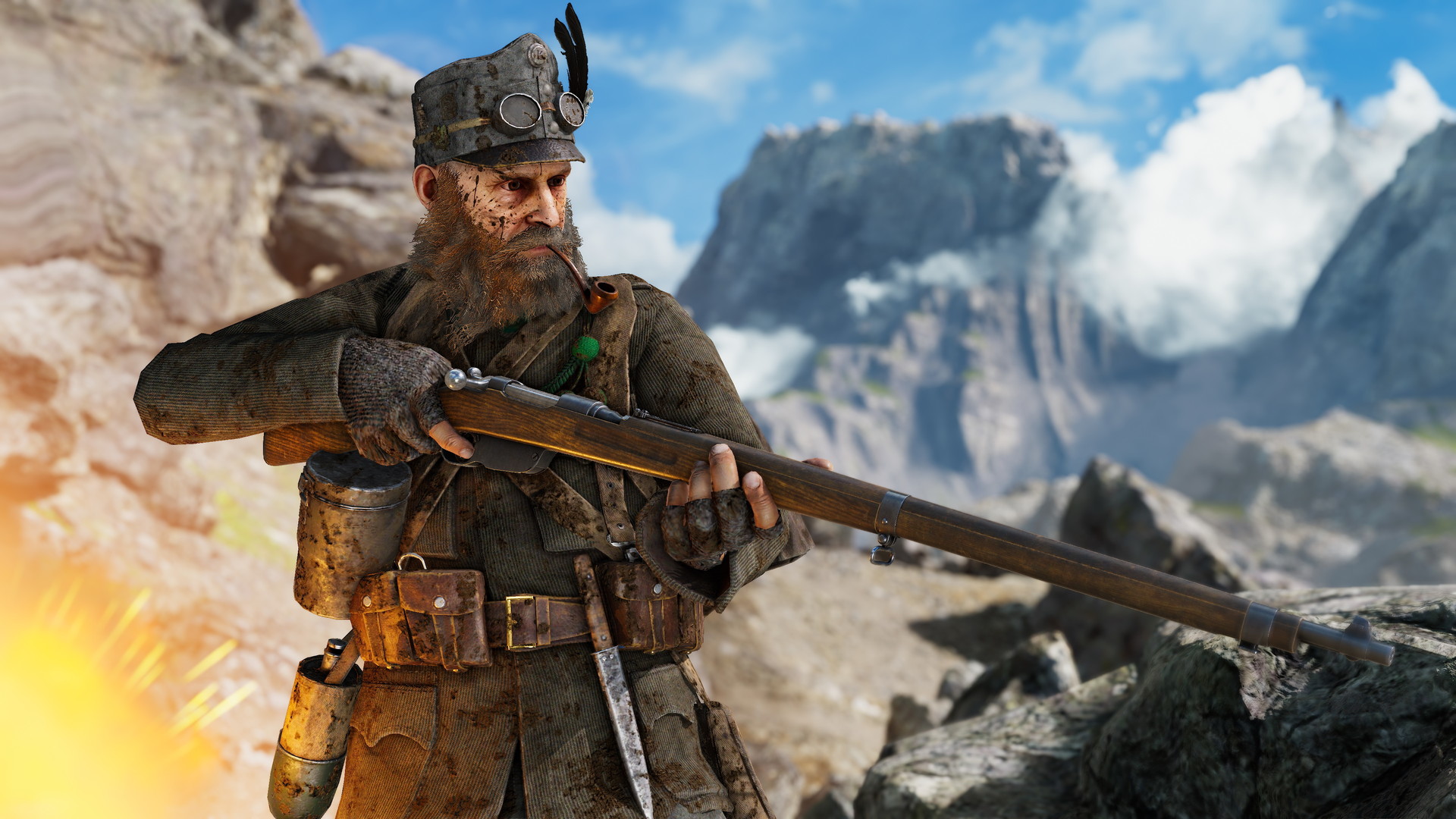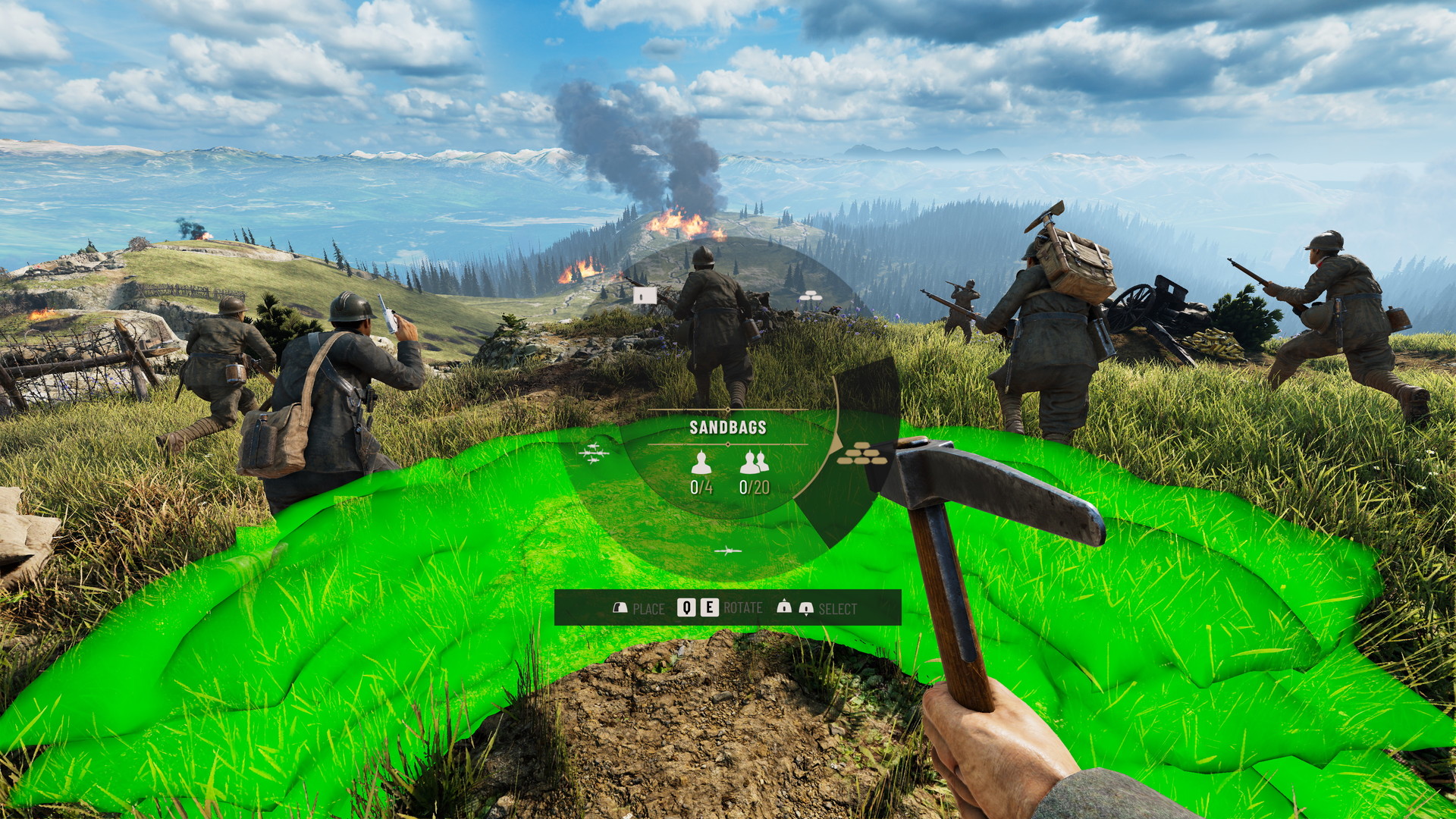World War One expands to the mountains of the Italian Front - beautiful but deadly in equal measure. Inspired by the two year struggle for control of the Isonzo river valley and the Alps during World War One, Isonzo elevates the WW1 Games Series, figuratively and literally.
From the makers of Verdun and Tannenberg …
The new Offensive game mode puts you right in the middle of key historical offensives on the Italian Front. Lead the charge across stunning Italian landscapes as you choose your path to victory - cut paths through barbed wire, flank your enemies by following mountain trails, or man a mortar to blast a way through. Shape a dynamic battlefield by laying sandbags and wire, placing ammo crates, deploying trench periscopes or sniper shields, and more.

Take part in historical offensives from the Sixth Battle of the Isonzo to the Strafexpedition. Reflecting the course of the actual battles, as the attackers advance the fighting will shift through vastly different landscapes within a single offensive: from hillside fortresses to mountain trenches and fierce urban combat on city streets. Everything is recreated based on research and field trips, from sound effects and uniforms down to the houses, vineyards and trenches you’ll be fighting over.
Call in support with a unique historically accurate flare system: flare guns can mark targets for artillery or biplane flybys, or different colored flares can be used to guide your team. Once the big guns have softened up the enemy, finish the job at close quarters with an Arditi dagger or mountaineer’s pickaxe. Man heavy machine guns, mortars and even mountain guns for more direct fire support.

Choose from six classes based on historical combat roles and build your loadout from a selection of weapons, equipment and perks linked to that class, giving flexibility and variety while staying grounded in what real soldiers might have carried. You’ll be operating wire cutters, bandaging yourself and wounded teammates, and blowing the whistle to start an assault. One shot can kill and even lighter injuries can lead to quickly bleeding out.
Being an effective soldier in Isonzo is not just about being a good marksman. Mastering the terrain is also key - the mountain can be a friend or foe. Learn how to navigate well to maintain cover and surprise your enemies or support your allies.
Finally… watch out for the dreaded poison gas. You’ve never experienced WW1 action quite like this!
Isonzo key features include:
More Games in the Authentic WW1 Game Series
Immerse yourself in more WW1 action with our other standalone titles Tannenberg and Verdun. Experience trench warfare on the Western Front in Verdun, or maneuver for control of key sectors in Tannenberg on the Eastern Front. These authentic WW1 shooters let players choose from a range of squads from across the war, as they fight for control of the ever-changing frontlines.
From the makers of Verdun and Tannenberg …
The new Offensive game mode puts you right in the middle of key historical offensives on the Italian Front. Lead the charge across stunning Italian landscapes as you choose your path to victory - cut paths through barbed wire, flank your enemies by following mountain trails, or man a mortar to blast a way through. Shape a dynamic battlefield by laying sandbags and wire, placing ammo crates, deploying trench periscopes or sniper shields, and more.

Take part in historical offensives from the Sixth Battle of the Isonzo to the Strafexpedition. Reflecting the course of the actual battles, as the attackers advance the fighting will shift through vastly different landscapes within a single offensive: from hillside fortresses to mountain trenches and fierce urban combat on city streets. Everything is recreated based on research and field trips, from sound effects and uniforms down to the houses, vineyards and trenches you’ll be fighting over.

Call in support with a unique historically accurate flare system: flare guns can mark targets for artillery or biplane flybys, or different colored flares can be used to guide your team. Once the big guns have softened up the enemy, finish the job at close quarters with an Arditi dagger or mountaineer’s pickaxe. Man heavy machine guns, mortars and even mountain guns for more direct fire support.

Choose from six classes based on historical combat roles and build your loadout from a selection of weapons, equipment and perks linked to that class, giving flexibility and variety while staying grounded in what real soldiers might have carried. You’ll be operating wire cutters, bandaging yourself and wounded teammates, and blowing the whistle to start an assault. One shot can kill and even lighter injuries can lead to quickly bleeding out.
Being an effective soldier in Isonzo is not just about being a good marksman. Mastering the terrain is also key - the mountain can be a friend or foe. Learn how to navigate well to maintain cover and surprise your enemies or support your allies.
Finally… watch out for the dreaded poison gas. You’ve never experienced WW1 action quite like this!
Isonzo key features include:
- Mountain warfare: Assaulting mountain fortifications, battling through ruined towns, and fording rivers are just a few of the challenges you’ll face as you fight your way through numerous enemy positions
- Tactical multiplayer FPS: Choose your role and loadout carefully to survive this high altitude combat - play a sniper to pick off the enemy engineers before they can cut your wire, use rifle grenades to clear enemy machine guns, and much more
- World War One Gameplay: Historical Offensive game mode based on real battles and focused on the unique challenges of Alpine warfare. Fight with 30+ WW1 weapons, poisonous gas attacks, and intense artillery barrages
- Build for victory: Place your own wire, sandbags, trench periscopes, and more! Whether you’re digging in or on the attack, shaping the battlefield to your advantage will be key to victory
- Faces of war: Make every class your own by picking from a variety of historically class-appropriate uniforms, accessories and headgear. As a finishing touch, you can even pick your mustache from several famous period-accurate styles!
- Authentic WW1 atmosphere: Accuracy in everything from maps and weaponry to music and the uniforms – fight for the Kingdom of Italy or the Austro-Hungarian Dual Monarchy

More Games in the Authentic WW1 Game Series
Immerse yourself in more WW1 action with our other standalone titles Tannenberg and Verdun. Experience trench warfare on the Western Front in Verdun, or maneuver for control of key sectors in Tannenberg on the Eastern Front. These authentic WW1 shooters let players choose from a range of squads from across the war, as they fight for control of the ever-changing frontlines.
The Montello Cycling Tour: Nervesa of the Battle [#6]
We speed down the hill and end up on a larger road (I hope your breaks work). Taking a left, our stop is just up ahead.


[hr][/hr]
We arrive at the central square of Nervesa della Battaglia; probably a familiar name by now, as it's the village we recreated on the Montello map. In fact, you can find this very fountain in game as well!


Nervesa della Battaglia is a village (or comune) with a population of about 6,500. We already mentioned some of its long history while cycling over Montello, but here's a quick rundown.
Based on archeological finds, it's assumed the Romans built a fortress on the site of present-day Nervesa in the first century. The surrounding area was involved in the centuriation of Treviso, a system used to divide land among the Roman populace. Nervesa was first documented by the Holy Roman Empire in 954 as Nervisia and gifted to the Collalto family.
Fast forwarding a bit, we arrive at the latter half of WW1. After the Italian defeat during the Battle of Caporetto, Austro-Hungarian forces pushed across the Piave river in June 1918, in an attempt to create a foothold across the river and eliminate the natural defenses it offered to the Italians. The Austrian forces initially succeeded, but were stopped in their further advances south towards Bavaria (no, not the German state) and Arcade (no, not the game kind) by the Italian counteroffensive. French artillery bombarded the Austro-Hungarians, their walkways across the river as well as Nervesa, forcing them back to the defensive.

After a week of fighting (during which Francesco Baracca was downed), Italian forces got the upperhand and the Austro-Hungarians decided to retreat back across the river. This marked the end of the role Nervesa played in WW1. Hours after the retreat, the Italian King Vittorio Emanuele III visited the village only to find it razed to the ground from the fighting and artillery.


While not much remained of Nervesa after the war, this wasn't the end of the village (which probably isn't very surprising considering where we are). Its people returned and the population even exceeded pre-war numbers by 1921. Around this time, Nervesa was renamed Nervesa della Battaglia, or "Nervesa of the Battle", referring to the Second Battle of the Piave.
Today, Nervesa della Battaglia is an industrial village supported by the local agricultural sector. In the surrounding industrialized areas of Dus, Bidasio and Foscarini, you'll find producers of everything from concrete to gelato.
The village itself is quite a typical, idyllic Italian comune. Its main attractions are many of the places we've talked about already, like the shrine to Francesco Baracca and the military ossuary. However, it is very beautiful here, so be sure to explore and grab a bite if you're ever nearby visiting the historical landmarks.

Next time, we wrap up the cycling tour! We'll arrive at our last stop, the old train station of Nervesa della Battaglia. The route we'll take isn't the fastest option, but it allows us to see a bit more of the village.
 The route on Google Maps
The route on Google Maps
[hr][/hr]
[table noborder=1]
For bike renting and a historic tour with possibility for a meal.
Looking for your next holiday destination?
Want to learn more about WW1 and the history of the area?
[hr][/hr]
To celebrate the release of the Montello Expansion, we bring you the Montello Cycling Tour! You'll likely see people here, act natural.
In the Cycling Tour, we'll be exploring the area represented in the Montello map. There's a lot of history to be found here, from the very structures that played a role in this battle to the monuments erected in memory della Grande Guerra. Every Friday we'll make a new stop at one of these historic locations until we arrive at our final destination: The Nervesa della Battaglia train station.
Previously: Visiting the Fallen [#5]
https://store.steampowered.com/news/app/1556790/view/4704663339700706595We speed down the hill and end up on a larger road (I hope your breaks work). Taking a left, our stop is just up ahead.


[hr][/hr]
Stop #6: Fontana di Piazza la Piave
We arrive at the central square of Nervesa della Battaglia; probably a familiar name by now, as it's the village we recreated on the Montello map. In fact, you can find this very fountain in game as well!


Nervesa della Battaglia is a village (or comune) with a population of about 6,500. We already mentioned some of its long history while cycling over Montello, but here's a quick rundown.
A brief pre-WW1 history
Based on archeological finds, it's assumed the Romans built a fortress on the site of present-day Nervesa in the first century. The surrounding area was involved in the centuriation of Treviso, a system used to divide land among the Roman populace. Nervesa was first documented by the Holy Roman Empire in 954 as Nervisia and gifted to the Collalto family.
The Second Battle of the Piave
Fast forwarding a bit, we arrive at the latter half of WW1. After the Italian defeat during the Battle of Caporetto, Austro-Hungarian forces pushed across the Piave river in June 1918, in an attempt to create a foothold across the river and eliminate the natural defenses it offered to the Italians. The Austrian forces initially succeeded, but were stopped in their further advances south towards Bavaria (no, not the German state) and Arcade (no, not the game kind) by the Italian counteroffensive. French artillery bombarded the Austro-Hungarians, their walkways across the river as well as Nervesa, forcing them back to the defensive.

After a week of fighting (during which Francesco Baracca was downed), Italian forces got the upperhand and the Austro-Hungarians decided to retreat back across the river. This marked the end of the role Nervesa played in WW1. Hours after the retreat, the Italian King Vittorio Emanuele III visited the village only to find it razed to the ground from the fighting and artillery.


Modern day Nervesa
While not much remained of Nervesa after the war, this wasn't the end of the village (which probably isn't very surprising considering where we are). Its people returned and the population even exceeded pre-war numbers by 1921. Around this time, Nervesa was renamed Nervesa della Battaglia, or "Nervesa of the Battle", referring to the Second Battle of the Piave.
Today, Nervesa della Battaglia is an industrial village supported by the local agricultural sector. In the surrounding industrialized areas of Dus, Bidasio and Foscarini, you'll find producers of everything from concrete to gelato.
The village itself is quite a typical, idyllic Italian comune. Its main attractions are many of the places we've talked about already, like the shrine to Francesco Baracca and the military ossuary. However, it is very beautiful here, so be sure to explore and grab a bite if you're ever nearby visiting the historical landmarks.

Up next
Next time, we wrap up the cycling tour! We'll arrive at our last stop, the old train station of Nervesa della Battaglia. The route we'll take isn't the fastest option, but it allows us to see a bit more of the village.
 The route on Google Maps
The route on Google Maps [hr][/hr]
Visit Montello!
The Montello Cycling Tour is a collaboration with local organizations. We'd like to thank them for helping us out with information about the region, the history and photos they provided. If you're interested in visiting the area, please check them out and tell them we sent you![table noborder=1]

For bike renting and a historic tour with possibility for a meal.
Bike Rental Montello
https://aglizattieri.com/
Looking for your next holiday destination?
Visit Prosecco Hills
https://visitproseccohills.it/en
Want to learn more about WW1 and the history of the area?
Museo della Battaglia di Vittorio Veneto
Location on Google Maps[hr][/hr]
Follow our socials:
X / Twitter YouTube Discord Reddit[ 2024-10-11 12:00:45 CET ] [Original Post]
Minimum Setup
- OS: Requires a 64-bit processor and operating system
- Processor: Intel Core 2 Quad Q9550Memory: 4 GB RAM
- Memory: 4 GB RAM
- Graphics: NVIDIA GeForce GT 640
- Storage: 20 GB available space
Recommended Setup
- OS: Requires a 64-bit processor and operating system
- Processor: Intel i7-4770Memory: 16 GB RAM
- Graphics: NVIDIA GeForce GTX 1050
- Storage: 20 GB available space
GAMEBILLET
[ 6445 ]
GAMERSGATE
[ 4292 ]
MacGamestore
[ 5362 ]
FANATICAL BUNDLES
HUMBLE BUNDLES
by buying games/dlcs from affiliate links you are supporting tuxDB

